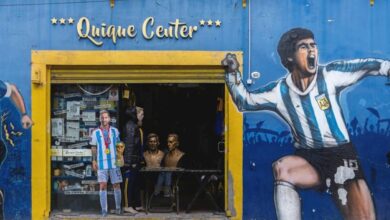CONMEBOL Wants UEFA Football in South America. Error or Success?
Establishing the only final in the Libertadores and in the Sudamericana, as well as including the teams that make it up in the Nations League, are part of the measures with which CONMEBOL intends to maintain a competitive level that attracts fans.

Photo: Conmebol
LatinAmerican Post | Juan Andrés Rodríguez Murillo
Escucha este artículo
Leer en español: CONMEBOL quiere un fútbol de UEFA en Suramérica. ¿Error o acierto?
The South American Football Confederation, CONMEBOL, led by Paraguayan Alejandro Domínguez, has undergone many changes in the last decade. Various measures taken have shown a tendency to bring South American football as close as possible to European football. An example is playing the two club tournaments in his charge all year round and choosing a venue for the final of those tournaments.
Read also: Opinion: For France Football, the failure of Manchester City is the example
As for national teams, the signing of a collaboration agreement with the Union of European Football Federations (UEFA, for its acronym in French) has made it possible to revive the Finalissima (the CONMEBOL-UEFA Champions Cup that Argentina won against Italy this year) and include the ten South American countries in the Nation's League. How successful has the South American federation been?
Unique Final, Like in the Champions
This Saturday, October 29, the final of the Copa Libertadores 2022 will be played between Flamengo and Atlético Paranaense. This is the third consecutive final between teams from Brazil and the fourth with a single final in a previously chosen venue: the Banco Pichincha Stadium in Guayaquil, Ecuador, home of Barcelona.
Since CONMEBOL decided to establish the only final for the most important club tournament on the continent, in the style of the Champions League, it has been questioned whether it is the best way for the tournament. Among the doubts that arise is the issue of ticketing: by Saturday, 11,000 tickets have been sold, which leaves a surplus of 44,000 available. Previous estimates made by the government of Ecuador, spoke of 50 thousand people; which translated into 50 million dollars, according to the Minister of Tourism, Niels Olsen.
According to Andrés Luna, an Ecuadorian sports journalist, the problem with the single final lies in the approach that CONMEBOL intends, giving priority to tourists and leaving aside soccer fans from the city on duty. The cost of the tickets ($245, the cheapest) alienates Ecuadorian fans. “It is probably the most expensive ticket in the history of Ecuadorian soccer,” he says.
For this year's Copa Sudamericana final, which was played by Independiente del Valle (Ecuador) and Sao Pablo (Brazil), the doors were opened so that the Mario Alberto Kempes stadium (Córdoba, Argentina) had more fans in the stands, indicates Luna. Despite the above, a large part of the empty stadium could be seen in the broadcasts.
The Ecuadorian journalist warns that in Guayaquil, free access could not be allowed due to the security problems that the country faces: "Daily, there are between 20 and 30 murders." Ecuadorians' minds are not focused on the event, but on the concerns they face every day: robberies, murders, gang confrontations. This, added to the costs, alienates the local fan base.
South America vs. Europe Most Often
In contrast to the criticism that has arisen with decisions at the club level, the agreement between CONMEBOL and UEFA to include South America in the Nations League from 2024 has not generated as many opinions in the press.
The tournament, which began to be played in 2018, replaced the dates of friendly games to establish greater competitiveness and offer greater economic benefits by broadcasting matches and prizes, since the sale of rights is made for the competition, not for individual matches.
The Nation's League is divided into leagues—A, B, C, and D—with promotion and relegation. Six CONMEBOL countries will enter the A league: Brazil, Argentina. Uruguay, Paraguay, Chile, and Colombia; the other four will do so in league B: Ecuador, Peru, Bolivia and Venezuela, according to UEFA vice president Zbigniew Boniek.
The possibility of playing frequently with high-level teams caught the attention of the Mexican press. Mexico has been a recurring participant in the Copa América and, at the time, in the Copa Libertadores and the Copa Sudamericana. Journalist Uriel Salmerón published last year in 90min a column entitled "The benefits that Mexican soccer would obtain if it participated in the Nations League together with CONMEBOL" where he explained the need to measure himself against Germany, France, Belgium, etc. Obligatory crossings for the A league teams.
Awaiting Results
According to the FIFA ranking and the bookmakers, Brazil and Argentina are among the five most likely teams to win the 2022 World Cup in Qatar. The performance of the other two classified, Ecuador and Uruguay, plus the confirmation of the candidates, will show what So close or far is South America from the European level.
In clubs, on the other hand, the gap seems immovable: since Corinthians in 2012, UEFA has dominated the Club World Cup. Even teams from the Asian Football Confederation and the Confederation of North, Central America and Caribbean Football, Concacaf, have slipped in.
The single-game final does not seem to attract the public of the continent, which continues to remember the distances and costs of travel between South American countries, where there are no connecting train lines and there are 7 billion more kilometers of surface. In the absence of data that unifies the television audience at the South American level, it remains to ask those close to them if they remember the final that Independiente del Valle won or if they are scheduled to enjoy the Libertadores final this weekend.




